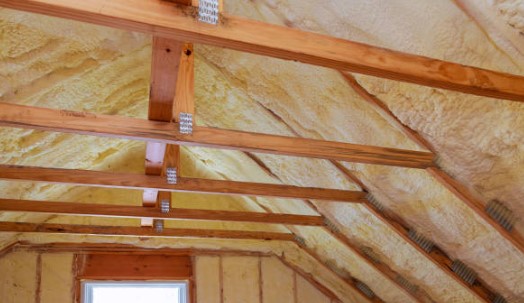Our homes are not just made up of four walls, they are made up of our dreams and hopes. We deserve a cozy home where we can be comfortable and at ease. The comfort of our homes depends on a number of factors, and one of the important ones is temperature control. A well insulated home allows us to experience the comfort of consistent temperatures. Not only does good insulation make our space pleasant, it also helps us save energy. For your convenience, here is a list of the most common home insulations along with their advantages and disadvantages.
Spray Foam Insulation
A unique type of insulation, spray foam is created by a mixture of liquid components which expands when it comes in contact with solid spaces, insulating and sealing gaps. Spray foam is versatile and great for sealing spaces and creating air barriers that prevents allergens and pollutants from entering your home, creating a comfortable space for you. You choose from open-cell or closed-cell solutions depending on what suits your home the best. The advantages of spray foam are numerous. Not only does it save energy by increasing heat transfer and convection, it's expanding nature also makes it perfect for insulating uneven spaces, like gaps in your walls, attics and crawl space. Moreover, mold and mildew are unlikely to grow on spray foam insulation; keeping your home fresh and free of pest infestation. The R-value, which measures “how much resistance the insulation has to heat flow,” of the spray foam insulation is high and does not decrease over time. Insulations with higher R value are more effective and efficient. However, there are some disadvantages of this type of insulation. It is comparatively more expensive to install than other types of insulations and professionals are required for the installation. It can also contract over time reducing its insulation capabilities.
Cellulose Insulation
A popular and traditional form of insulation, cellulose is a fiber insulation made from recycled paper or recycled denim. Depending on what is needed you can choose from blown in cellulose insulation or loose fill cellulose insulation. The former is installed with the help of a machine that uses a hose to blast the insulation into the wall cavity or attic. The latter is installed by pouring it directly into the attic or wall cavity. Both types of cellulose insulation can be used in both residential and commercial buildings. The benefits of loose fill insulation are various. It is a great eco-friendly option that perfectly fits into tight spaces, such as attics and crawlspaces. It not only makes your home energy efficient, it also is fire, pest and mold resistant. The disadvantages of loose fill insulation is that it is more costly than other insulation materials and it can only be installed by professionals. It is also prone to absorption of water as well as compressing with age. The R-value of loose-fill insulation is high when it is first installed, but it can decrease with time.
Fiberglass Insulation
A pretty popular type of thermal insulation, fiberglass insulation is made by spinning or blowing glass fibers into insulation. It is available in a blanket form called batts or as loose-fill insulation, the latter as mentioned previously is best for crawlspaces and attics. There are both advantages and disadvantages of this type of insulation. Fiberglass insulation with its high R-value is energy efficient as well as flexible and fire retardant. It is not only eco-friendly but also has noise canceling properties making it perfect for anyone who wants a quiet home. However, fiberglass is comparatively less dense and hence not as effective in restricting air exchange. It is also not as effective at repelling moisture which can lead to formation of mold spores. If that happens, the insulation needs to be immediately changed. The batts form of insulation is not suitable to fit into small spaces.
Conclusion
Our homes are a significant part of our lives and it is essential that we create a comfortable and cozy home that makes the space our own. The first step is in deciding which type of insulation will best fit our needs, and these three energy-efficient insulations are great for any home!










